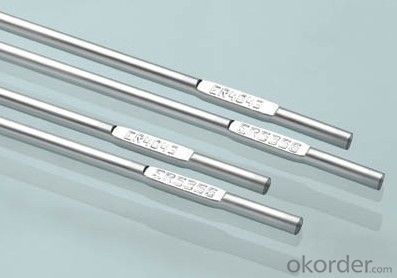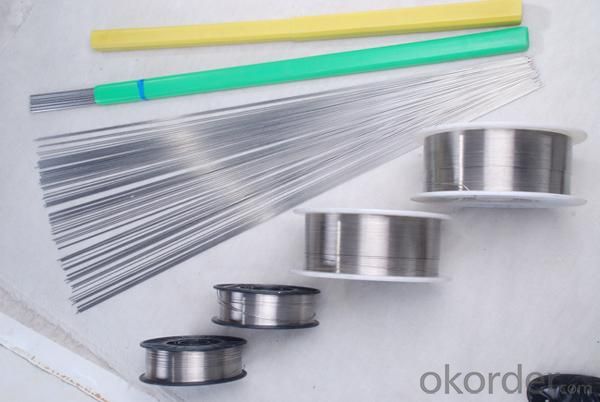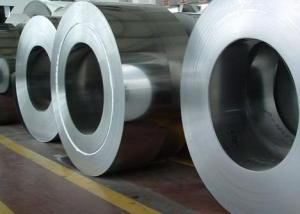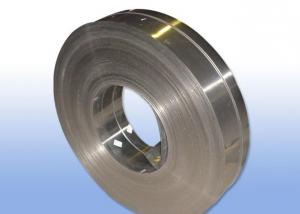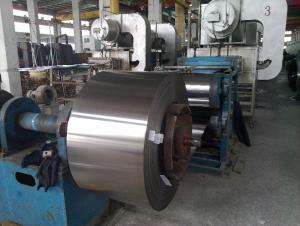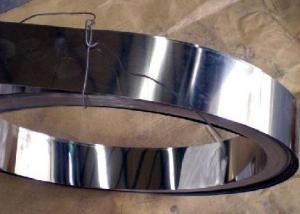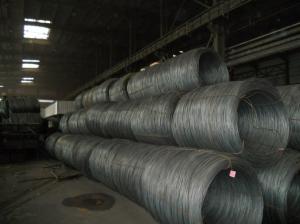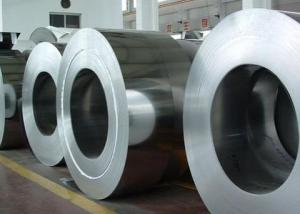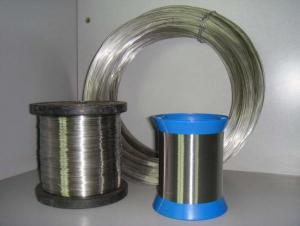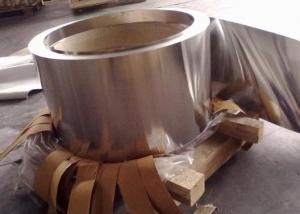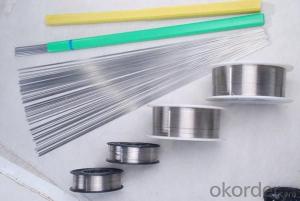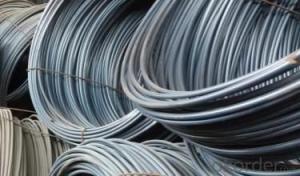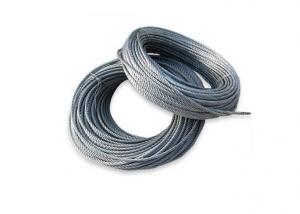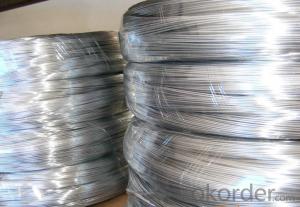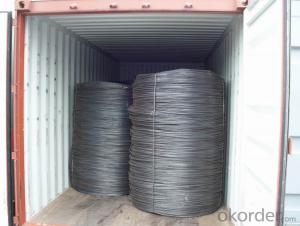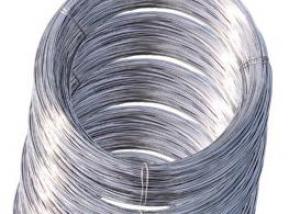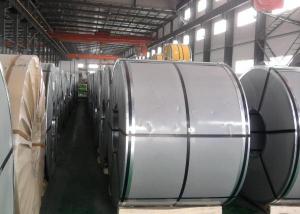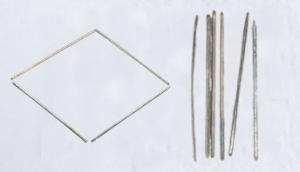Carbon welding electrode /Titanium welding rods
- Loading Port:
- Qingdao
- Payment Terms:
- TT OR LC
- Min Order Qty:
- 1 m.t.
- Supply Capability:
- 100 m.t./month
OKorder Service Pledge
OKorder Financial Service
You Might Also Like
Specifications
1)Pure aluminum -99% min
2)Excellent corrosion resistance.
3)High thermal conductivity and electrical conductivity.
Class: ER1100
AWS: A5.10
Conforms to Certification: AWS A5.10 ASME SFA A5.10
Weld Process: Tig (GTAW)
| AWS Chemical Composition Requirements | |
| Cu = 0.05 – 0.20 | Al = 99.0 min |
| Mn = 0.05 max | Si + Fe = 0.95 max |
| Zn = 0.10 max | Be = 0.0003 max |
| Other = 0.05 each – 0.15 total | |
Available Sizes:
Upon Request, call for more information
Application
Type ER1100 can be used to weld base materials types 1060, 1070, 1080, and 3003.
Welding Filler Wire
Heat Exchangers
Food Handling Equipment
Rivets
The proper choice of aluminum filler metal mainly depends on the base metal properties to be achieved and welding technique. Post weld cracking, corrosion resistance and behavior under elevated temperature also need to be taken into consideration. Cracking usually can be minimized by choosing a filler metal alloy of higher alloy content then the base metal.
Deposited Chemical Composition % (Typical)
Deposited chemistry is influenced by many factors so no typical analysis can be reported.
Deposited All Weld Metal Properties %
As-Welded
Deposited all weld metal properties are influenced by many factors such as weld process used, so no typical weld metal properties can be reported.
- Q: Several ways of drawing stainless steel wire drawing.
- According to decorate need drawing straight lines, made several chaotic patterns, thread, corrugated and twistcore. Straight line drawing refers to the surface of aluminum processing with a mechanical friction method of straight lines. It has the dual role of brushed aluminum plate surface scratches and decorative aluminum surface. A continuous wire drawing straight lines and intermittent thread two. Continuous threads available 100 clean cloth or stainless steel brush through continuous horizontal lines on the surface of aluminum friction (such as in the device under the condition of * manual skill grinding or planer clamped in the aluminum wire brush grinding brush).
- Q: Can stainless steel wire be used for aircraft components?
- Yes, stainless steel wire can be used for aircraft components. Stainless steel is widely used in the aerospace industry due to its high strength, corrosion resistance, and durability. It is commonly used for various applications such as wiring, cables, fasteners, and structural components in aircraft manufacturing.
- Q: What are the different types of stainless steel wire used in food processing applications?
- There are several types of stainless steel wire commonly used in food processing applications. These include AISI 304, AISI 316, AISI 321, and AISI 430. Each type has its own unique properties and is chosen based on the specific requirements of the food processing application.
- Q: What is the maximum continuous operating temperature for stainless steel wire?
- The maximum continuous operating temperature for stainless steel wire depends on the specific grade of stainless steel being used. Generally, stainless steel wires can withstand higher temperatures compared to other materials. The maximum continuous operating temperature for most stainless steel wires ranges between 550-800 degrees Celsius (1022-1472 degrees Fahrenheit). However, it is important to note that the exact temperature limit may vary depending on factors such as the grade of stainless steel, the specific application, and any additional factors such as environmental conditions or stress levels. It is always recommended to consult the manufacturer's specifications or seek professional advice to determine the maximum continuous operating temperature for a specific stainless steel wire.
- Q: What's the difference between galvanized iron wire and stainless steel wire?
- Stainless steel wire and stainless steel wire, various specifications and models of silk production as raw materials of stainless steel, the origin of the United States, Holland, Japan, the general section is round or flat. Common stainless steel wire with good corrosion resistance and high performance price ratio is 304 and 316 stainless steel wire.
- Q: Can stainless steel wire be used for springs in the construction industry?
- Yes, stainless steel wire can be used for springs in the construction industry. Stainless steel is known for its durability, corrosion resistance, and high tensile strength, making it a suitable material for springs that require strength and longevity. Additionally, stainless steel springs can withstand harsh environmental conditions and are commonly used in various construction applications such as doors, windows, and mechanical systems.
- Q: Can stainless steel wire be used for wire rope tensioners?
- Yes, stainless steel wire can be used for wire rope tensioners. Stainless steel is a strong and durable material that is commonly used in various applications, including wire rope tensioners. It offers excellent resistance to corrosion, making it suitable for outdoor and marine environments where exposure to moisture and harsh conditions is common. Stainless steel wire rope tensioners provide reliable and long-lasting tensioning of wire ropes, ensuring their stability and strength.
- Q: Is stainless steel wire corrosion-resistant?
- Absolutely, stainless steel wire exhibits exceptional corrosion resistance. Comprised of an alloy rich in chromium, stainless steel forms a shielding oxide layer on its surface, effectively obstructing the infiltration of oxygen and moisture and consequently minimizing the likelihood of corrosion. Moreover, the high chromium concentration fortifies the wire's ability to withstand corrosive substances like acids and chemicals, rendering it appropriate for a wide range of vital applications, including marine environments and outdoor surroundings.
- Q: What are the different types of stainless steel wire ties?
- There are several types of stainless steel wire ties, including standard stainless steel wire ties, coated stainless steel wire ties, self-locking stainless steel wire ties, and stainless steel cable ties with insulation.
- Q: Can stainless steel wire be used for wire knitting or crocheting?
- Yes, stainless steel wire can be used for wire knitting or crocheting. Stainless steel wire is a versatile material that is strong and durable, making it suitable for various crafting projects, including wire knitting or crocheting. It offers a unique aesthetic with its shiny and metallic appearance, making it a popular choice for jewelry making and other decorative items. Additionally, stainless steel wire is resistant to corrosion and tarnish, ensuring that your creations will last longer and maintain their quality. However, it is important to note that stainless steel wire may be harder to work with compared to other types of wire, as it is less flexible and may require specialized tools or techniques.
Send your message to us
Carbon welding electrode /Titanium welding rods
- Loading Port:
- Qingdao
- Payment Terms:
- TT OR LC
- Min Order Qty:
- 1 m.t.
- Supply Capability:
- 100 m.t./month
OKorder Service Pledge
OKorder Financial Service
Similar products
Hot products
Hot Searches
Related keywords


